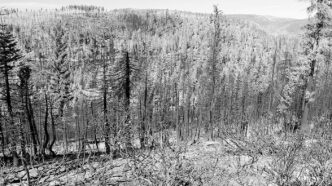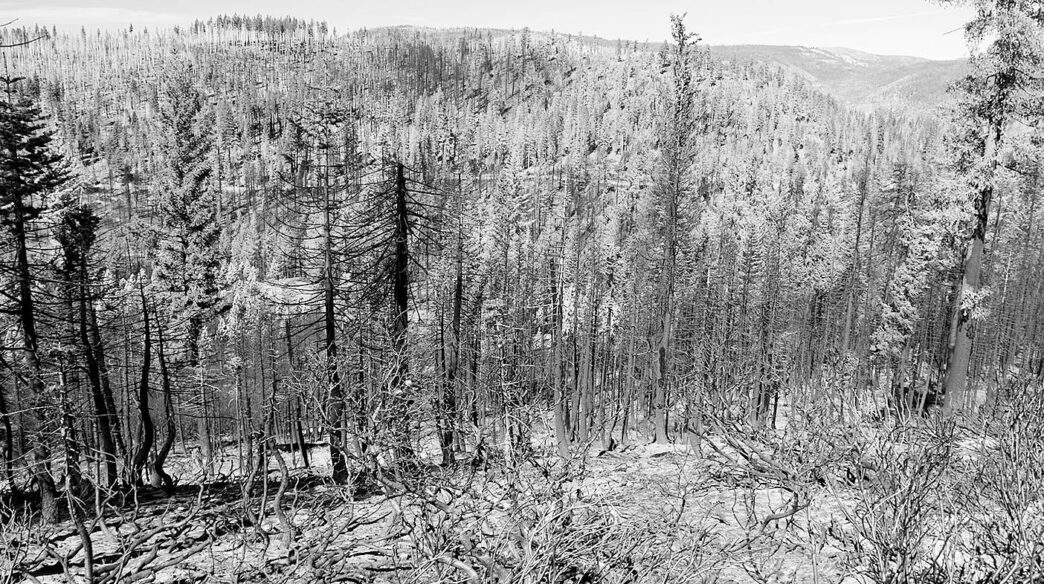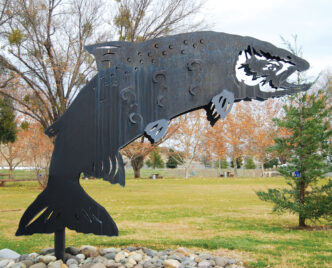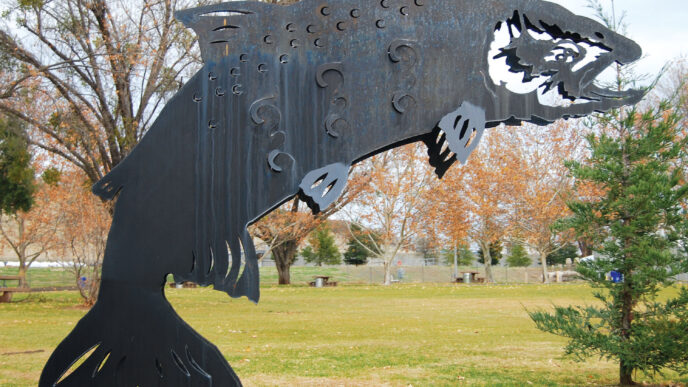Thirteen years ago, I sat on a lonely rock outcrop and called in field observations that would mobilize a massive backfire. It was 2002, and I was working as the federally recognized field observer (FOBS) on a large incident just north and east of the infamous Biscuit Fire in the Siskiyou National Forest. If it weren’t for Biscuit, our fire would have been the lead story on the national news.
Field observer is one of the finest job titles in the history of human civilization. The mission is to observe fire behavior, fuel types, topography, and local weather patterns and identify resources at risk, escape routes, and safe zones. A field observer’s findings, briefings, and maps go to the plans section of the overhead command team, but a field observer really never reports to a boss. As a “single resource,” I was called to disasters all over the West, and as long as I did a good job, generally I got all of the resources I needed, including helicopters, trucks, cool electronic devices, and sometimes even a hot meal. What more could one ask for?
I was repeatedly told by seasoned veterans that the fire weather of 2002 was a once-in-a-lifetime event. Biscuit burned nearly half a million acres in Northern California and Oregon. The Oregon portion of the complex alone was and still is the largest fire in the state’s history. By comparison, Yosemite’s Rim Fire of this last summer, though the largest wildfire ever recorded in the history of the Sierra, was several hundred thousand acres smaller than Biscuit. Like Biscuit, though, it has been described by firefighters as a once-in-a-lifetime event. Like Biscuit, the environmental, political, and social fallout has been as predictable as a sunrise.
Hard-core enviros want a hands-off policy regarding fire prevention and salvage logging. Far-right conservatives want to hand forest management over to private enterprise. And society at large doesn’t want to bother with the cost of forest thinning, the hassle of keeping their properties manicured for defensible space, or the nuisance of smoke from prescribed burning. This cycle has been spinning since Teddy Roosevelt created our national forests and our national wildland firefighting forces in 1905.
Many anglers are wondering what the fires of 2013 will do to California’s fisheries. Here is a reprint of an article I wrote on that rocky outcrop just over a decade ago.
It is the first week of August, and there is fire in the mountains. I’m sitting on a rock overlooking a steep, wooded canyon, and far below me, the river winds like copper wire through smoke-shrouded folds of cedar, fir, and madrone. Salmon, steelhead, and trout fin in its burnished waters. Moments ago, the helicopter clattered away, and in its silence, I’m left alone with a weather kit, laptop, radio, binoculars, and a few survival items.
The forest is brimming with life. A goshawk hitches a ride high in the thermals, then peels away, three flaps and a glide, three flaps and a glide, three flaps and she’s gone in the smoke. Chipmunks and lizards scamper through the ripening raspberries, and a pair of grouse brazenly strut below my feet to peck at bits of food hidden in the sharp gravel. An elk bugles, too early for rut, but perhaps the smoke-filled skies make him dream it is fall and with it all the lust and vigor that autumn will bring. It will be an autumn like he’s never known . . . if he and all the other creatures live to see it at all. I am about to bring fire into their lives. I am going to burn them out of house and home.
Over a hundred years of human intervention has created a fuel load that will not quietly go away. Given time, it will burn — it always has, and it always will. The environmentalists blame the loggers for leaving massive slash piles and unnaturally dense ladder fuels in their wake. The loggers blame the environmentalists for preventing them from harvesting the forest and thinning the fuels. The blame lies somewhere in the middle, but most of the blame must be levied on a society that can’t stomach the thought of fire in the forests. Fire suppression has led to a catastrophic buildup of forest fuels and the equally catastrophic firefighting techniques required to stop the resultant conflagrations.
I’m sitting on this rock watching the forest and its weather. When conditions are just right, I am going to make a 20-second radio call into Incident Command. That simple event will lead to a firefight of the most destructive type: a backfire. Hand crews on the line will ignite flame-spewing drip torches and paint fire into the trees. Others will walk fire lines and sweep hissing fusees, road flares with handles, into the flammable brush. Others will fire guns loaded with incendiary rounds that will put fire deep into the forest.
The most awesome of all are the helicopters that skim the treetops and set the forest ablaze. Some of the helicopters carry vats filled with napalm that they slop onto the forest canopy. Others carry the dreaded killer Ping-Pong balls, which penetrate the canopy and do their trick once they are amid the woody fuels of the forest floor. These Ping-Pong balls are filled with powdered potassium permanganate, and as they shuffle down the dispersal chute, they are injected with ethylene glycol, or antifreeze. Combined, these chemicals generate heat, until, some 20 seconds later, they burst into cheerful gouts of flame that will burn down the forest and everything in it. For this fire alone, forty thousand Ping-Pong balls have been ordered.
As fire burns, it creates heated air that rises. The rising air is replaced by cooler air that rushes along the forest floor. If everything goes right, and I don’t screw up my weather observations, our intentionally set backfire will get sucked toward the mother fire and consume all the fuels between it and our fire line. This backfire will burn hundreds of acres, but should save tens of thousands of acres in the process. Fighting fire with fire is risky, but the payoff is huge. When the fire is over, we will have won the battle, but by stopping its forward progress, we will have taken another step away from winning the war on overloaded forest fuels. We will probably never win the war, but we can make the battles a lot less ugly. Forest thinning by intelligent timber harvesting, combined with prescribed fires and mechanical thinning of unmarketable fuels, are the tools of long-term wildfire suppression.
What happens to the fish aquatic insects during fire and following its wake? Trout are well equipped to handle short periods of warm water, and radiant heat from the fire usually kills only those dwelling in the smallest creeks. However, smoke carries a potpourri of chemicals, one of which is ammonia, a compound highly toxic to aquatic life. Fish mortality can reach 100 percent in areas where smoke settles over the water for an extended period. Fortunately, carbon is a natural neutralizer of ammonia, and when charred timber and debris fall into the water, they effectively cleanse the habitat. Although fire suppression in riparian zones is a high priority, it can lead to unanticipated, though short-term negative side effects for aquatic inhabitants. Firefighting slurry and foam can kill trout when they enter the river environment, and where practical, the use of chemical fire retardants is avoided along riparian corridors.
Nutrient loading is high immediately following fire. Downed woody debris provides habitat for fish as well as cellulose for diatoms and other tiny creatures that form the foundation of the aquatic food web. Calcium, potassium, and magnesium released during the burn act as fertilizers to spur the growth of phytoplankton and rooted vegetation. Nitrogen is consumed by fire, and in some instances, the lack of it will be the limiting factor in postfire biomass recruitment.
Years after a fire, depending on stream gradient and flushing flows, which scrub the system of fire products, the aquatic system can develop a nutrient deficit because watershed flora is in a growth cycle, rather than a decay cycle. Lack of downed in-stream woody material can lead to loss of habitat and of food production. In riparian burns, the resultant lack of stream shading can result in prolonged periods of warm water, which can radically reduce salmonid carrying capacity. The loss of root structure can lead to erosion and bank destabilization.
Of all the effects that fire has on an aquatic system, though, ground and surface water dispersal is perhaps the most insidious and long-term. Fire can affect watershed soils many ways. Clay soil particles are normally flat and bed neatly atop one another, creating an impervious surface that enhances runoff. Heat from the fire can either clump or crack the individual clay particles, which allows water to penetrate the previously “waterproof ” soils. As fire burns out roots of watershed plants, the resulting subterranean hollows create a sponge that holds water. Both of these factors can contribute to the enhancement of groundwater stores at the expense of the surface water-transport systems — trout habitat.
On the other side of the coin, heat can change the polarity of some organic compounds found in the soils so that they coat the soil with aliphatic hydrocarbons that repel water much like powdered fly floatants do. Yet other soils will develop a patina or glaze that physically prevents water from soaking in.
The inability of soils to absorb water results in erosion as rapidly descending surface water picks up and transports fine soil particles. In a worst-case scenario, heavy rains immediately after a fire can wash enough sediment and ash slurry into the system to kill trout outright. Most erosion processes are less intense, but are ecologically dramatic, nonetheless. The silt and sand that ultimately fill the burned watershed creeks and streams have a profound effect on the aquatic habitat. Macroinvertebrates such as stonefly nymphs and most mayfly nymphs, which require a rocky substrate, perish.
Initially, the clogged system will be a desert, but nature quickly fills the vacuum with appropriate inhabitants. The first pioneers are the chironomid midges and Baetis mayflies. Both these insects undergo multiple life cycles per year, which allows them adapt quickly and to fill changing environments. (Aquatic ecologists know these insects as “disturbance-adaptive” species.) The vacant ecosystem is filled with nymphs and larvae that drift from lower-order waters or by adults that wing their way upstream upon emergence.
The river system may see new species that avoided the prefire freestone waters, with their cobbled beds. Tricorythodes and Caenis mayflies are specially suited for silted environments by sporting gills atop their backs, rather than on their bellies or sides, like most mayflies. Other macroinvertebrates burrow into the silt and sand to set up residence.
As time passes, the forest will mature and resume its growth-and-decay cycle. The ever-moving waters will eventually cleanse the streambeds of silt and displace organisms that live in the silt, replacing them with familiar freestone dwellers such as the stoneflies and clinger mayflies. The healthiest river, like the healthiest forest, is not one that has been recently burned or one that has reached stagnant maturity, but one that is in transition. A river with pockets of silt and sand interspersed with areas of cobble and rock hosts the greatest variety of species and thus has the greatest resiliency to withstand catastrophe.
Fire is neither good nor bad. It is simply part of a natural cycle. When we humans assign anthropomorphic values to natural events and attempt to intervene on our own behalf, we can only fail in the long run.
After four long hours, the rock is taking its toll on my back and legs. I take another set of weather readings and scan the forest. It smells of wind-scrubbed cedar and rich, loamy duff. The wind, temperature, and humidity have come into alignment.
A great horned owl hoots and is answered by another across the canyon. They are likely hunting the abundant flying squirrels, who scurry about the moss-draped trees, searching for edible fungus. I key the radio and say a few words to Incident Command. Against the dark, fusees spark to life with lethal intent, and in the distance, I feel as much as hear the throb of incoming helicopters.












